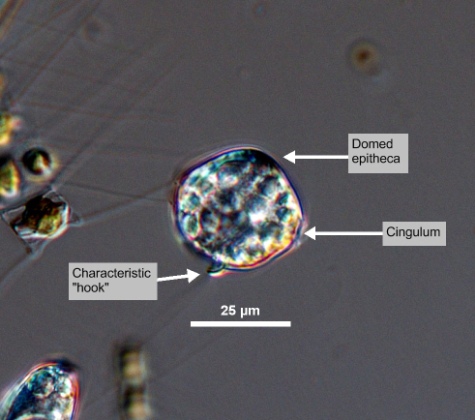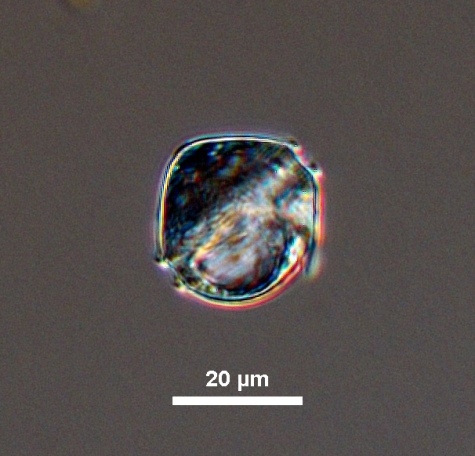



|
Synonym(s)
Glenodinium lenticula Pouchet 1883
Dissodinium lenticulum (Bergh) Loeblich III 1970
(Kraberg et al. 2010)
Classification
(Guiry and Guiry 2012)
Lifestyle
Pallium
(feeding) A mode of feeding used by some heterotrophic dinoflagellates. The dinoflagellate extrudes its cytoplasm, engulfing its food (often a cell or chain of cells). The food is digested outside the dinoflagellate's cell. The dinoflagellate then pulls its cytoplasm and its newly digested meal back inside its theca. This method of feeding allows dinoflagellates to eat food that is bigger than itself.
pallium (Kraberg et al. 2010). It produces round, brown CloseCyst
"A thick-walled dormant cell" (Horner 2002).
cysts (Kraberg et al. 2010).Description
Apical
(axis, spine) The region of the apex or point. Refers to the most anterior point or region of the cell (HPP 2003).
apically- CloseAntapical
Referring to the most posterior point of a cell. The opposite of apical.
antapically compressed (Kraberg et al. 2010). The cell might also look like a sphere that is flattened from pole to pole and has an apical pore (Subrahmanyan 1971). The cell has a large apical projection (cone) and prominent CloseSulcal list
(left and right) In dinokont dinoflagellates, a well-defined groove on the ventral surface that is supported by ribs.
sulcal lists (Smithsonian 2012) that produce a visible "hook".Measurements
Width: 35 - 70 μm
(Kraberg et al. 2010)
Similar species
Harmful effects
Habitat
Distribution
Cosmopolitan in cold temperate to tropical waters (Steidinger and Tangen 1997).
Although it is occasionally seen in spring and autumn, its peak abundance may occur in the summer months British Columbia and in the North Sea and adjacent waters (Kraberg et al. 2010).
Growth conditions
Environmental Ranges
Temperature range (°C): -1.893 - 23.128
Nitrate (μmol L-1): 0.476 - 12.829
Salinity: 24.378 - 36.252
Oxygen (mL L-1): 4.981 - 9.192
Phosphate (μmol L-1): 0.051 - 1.165
Close
Silicic acid
A general term to describe chemical compounds containing silicon, oxygen and hydrogen with a general formula of [SiOx(OH)4-2x]n. Diatoms polymerize silicic acid into biogenic silica to form their frustules (Azam and Chisholm 1976).
Silicate (μmol L-1): 1.030 - 35.210(EOL 2012)
Bloom characteristics
References
Encyclopedia of Life (EOL). 2012. Diplopsalis lenticula (Bergh) 1882. http://eol.org/pages/901352/details. Accessed 3 May 2012.
Guiry, M. D. and Guiry, G. M. 2012. Diplopsalis lenticula (Bergh) 1882. http://www.algaebase.org/search/species/detail/?species_id=60249. Accessed on 3 May 2012.
Kraberg, A., Baumann, M. and Durselen, C. D. 2010. Coastal Phytoplankton Photo Guide for Northern European Seas. Verlag Dr. Friedrich Pfeil, Munchen, Germany.203.
Subrahmanyan, R. 1971. The Dinophyceae of the Indian Seas. Marine Biological Association of India. 334.
Smithsonian Environmental Research Centre. 2012. Diplopsalis lenticula (Bergh) 1882. http://www.serc.si.edu/labs/phytoplankton/guide/dinoflagellates/diplop.aspx. Accessed 30 April 2012.
Steidinger, K. A. and Tangen, K. 1997. Dinoflagellates. In: Tomas, C. R. (ed.) Identifying Marine Phytoplankton. Academic Press, Inc., San Diego. 531.
